Military Aircraft Repositioned as Florida Bases Prepare for Hurricane Ian
Defense officials finalized preparations that included relocating military aircraft from bases around the state as Hurricane Ian began its assault on southwestern Florida Wednesday.

Capt. Davis White, 53rd Weather Reconnaissance Squadron aerial reconnaissance weather officer, monitors a radar screen during a flight into Hurricane Ian September 27, 2022. The 53rd WRS, or Hurricane Hunters, fly missions into hurricanes to collect data for forecasters at the National Hurricane Center. [Courtesy: U.S. Air Force]
As Hurricane Ian began to bear down on Florida's southwest coast Wednesday, defense officials relocated military aircraft, moored Navy ships, and completed final storm preparations ahead of one of the largest storms to strike the state in years.
“Clearly, this is a very powerful major hurricane that’s going to have major impacts, both on impact in southwest Florida, but then as it continues to work through the state,” Florida Gov. Ron DeSantis said Wednesday morning, the Orlando Sentinel reported. “It is going to have major, major impacts in terms of wind, in terms of rain, in terms of flooding, so this is going to be a nasty, nasty day—two days.”
Wednesday morning, the storm churned off the southwestern coast of Florida, with hurricane-force winds approaching near Sanibel Island, according to a 10 a.m. report from an Air Force Reserve Hurricane Hunter aircraft. Wind speeds were increasing to maximum sustained winds of 155 mph, just 2 mph shy of officially becoming a Category 5 storm.
By 11 a.m., "catastrophic wind damage" was beginning along the coast, the National Hurricane Center reported, warning that in its wake would be heavy rainfall and catastrophic flooding across portions of central Florida.
Hours earlier, as the storm maintained its advance in the Gulf, defense officials in Washington, D.C. announced that more than 3,200 of Florida's National Guard troops had been activated. An additional 1,800 troops, along with aviation assets, such as helicopters, remained on stand-by, Air Force Brig. Gen. Pat Ryder told reporters at the Pentagon.
"Florida has pre-positioned Guard soldiers, airmen and equipment at bases and armories around the state in preparation for deploying them to areas impacted by the storm," Ryder said. "These Guardsmen will provide route-clearing search and rescue teams to support flood control and security."
Scenes from today’s flight into #HurricaneIan as it makes its way toward Florida ✈️ 🌀
— Hurricane Hunters (@53rdWRS) September 27, 2022
Make sure you’re paying attention to the forecast (@NHC_Atlantic) as well as heeding local advisories.#ReserveReady pic.twitter.com/BY9JA1elKI
Bracing for the Storm
Hurricane preparations have been underway for months, Rear Adm. Jim Aiken, Commander U.S. Naval Forces Southern Command/U.S. 4th Fleet said Wednesday.
"Aircraft will initiate evacuations from area airfields or be secured in hangars rated to withstand hurricane force winds," the Navy Command said in a statement Wednesday. "Four ships and multiple rotary and fixed-wing aircraft are expected to relocate and remain out of the local area until it is determined safe to return."
All Navy aircraft not relocated will remain hangered between Naval Air Station Jacksonville (KNIP) and Naval Station Mayport (KNRB), the service said.
The Air Force began its preparations for Ian Monday with the evacuation of some aircraft from Air Force installations in the storm's path, an Air Force spokesperson told FLYING.
More than two dozen F-35A Lightning II aircraft were repositioned from Eglin Air Force Base (KVPS) to Barksdale Air Force Base (KBAD), Louisiana, ahead of the storm's expected damaging winds, the 33rd Fighter Wing said. Wednesday morning, the base was at a Hurricane Condition Level 5, or HURCON 5 status, meaning that surface winds were expected in excess of 58 mph (50 knots) within 96 hours.
Less than 100 miles away, Tyndall Air Force Base (KPAM) near Panama City was not under an evacuation order but warned that the base was at HURCON 4, with surface winds greater than 58 mph possible in 72 hours. According to the Air Force, the base's fleet of T-38 Talon supersonic jet trainers were tied down, while its F-22 aircraft were listed as "TBD."
Four years ago, Tyndall was decimated by Category 5-strength Hurricane Michael. Its current $5 billion reconstruction, which is about four years away from completion, marks the largest military construction project ever awarded, NBC News recently reported.
As of Wednesday afternoon, Air Force and Space Force aircraft preparations also included:
Hurlburt Air Force Base (KHRT)
- U-28 Dracos, MC-130J Commando IIs, repositioned to Eglin AFB, Florida
- AC-130J Ghostriders, MC-130Js, MC-130H Combat Talon IIs repositioned to Wright Patterson AFB, Ohio
- U-28s repositioned to Cannon AFB, New Mexico
- A-29 Super Tucanos repositioned to Kansas City, Missouri
- AC-130J, CV-22s and MC-130Js listed as "TBD"
Jacksonville International Airport (KJAX)
- F-15s Eagles repositioned to New Orleans, Louisiana
MacDill Air Force Base (KMCF)
- 9 KC-135 Stratotankers repositioned to Bangor, Maine
- 1 KC-135 repositioned to Pease, New Hampshire
- 15 UH-60 Black Hawks repositioned to Miami, Florida
Moody Air Force Base (KVAD)
- A-10 Thunderbolt IIs repositioned to Barksdale
Patrick Air Force Base (KCOF)
- C-130 Hercules repositioned to Little Rock AFB
- HH-60s repositioned to Orlando Convention Center and Little Rock AFB
- UH-1 Iroquois helicopters repositioned to Cape Canaveral, Florida
"Aircraft relocations are being conducted based on [wing commander] determinations so not all listed below are on the move at this time," an Air Force spokesperson said.
The DOD has designated Maxwell Air Force Base, Alabama; Moody Air Force Base, Georgia; Warner Robins Air Force Base, Georgia; and Marine Corps Logistics Base Albany, Georgia, as incident support base federal staging areas.
Live views of #HurricaneIan from the @Space_Station as it flies over the storm. https://t.co/hGjzrBmuyw
— NASA (@NASA) September 26, 2022
Sitting in the projected path of the storm, which is expected to begin cutting across much of central Florida Wednesday afternoon, is U.S. Central Command and U.S. Special Operations Command, both located at MacDill Air Force Base in Tampa.
MacDill Air Force Base issued a mandatory evacuation order for all non-essential personnel, including dependents and civilian employees as of noon Tuesday.
"Hurricanes hitting the state of Florida are not new," Ryder said. "There are very comprehensive contingency plans that are put together to address these types of eventualities to ensure that there's 24/7 connectivity and command and control capability. The bottom line is neither of those commands will miss a beat regardless of whether the storm hits in the Tampa area or not."

Sign-up for newsletters & special offers!
Get the latest FLYING stories & special offers delivered directly to your inbox






